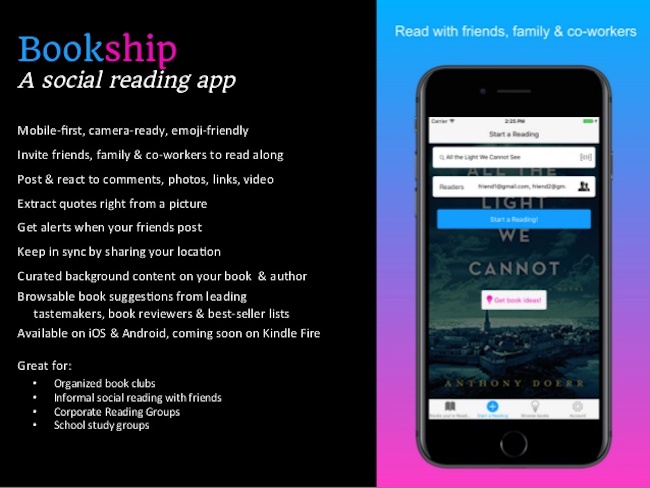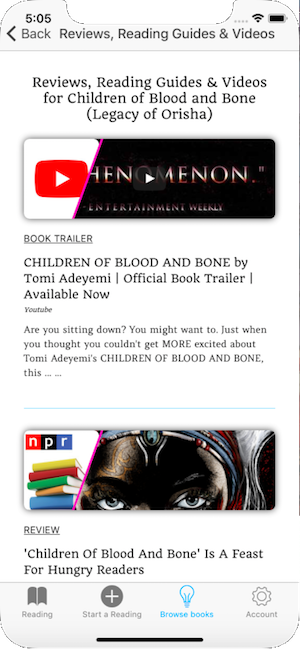What Bookship has learned about how social reading works
(The following appeared first in The Bookseller)
Last December, Bookship - an American “social reading app” aimed squarely at the Snapchat and Instagram generation - made it through to the final BookTech pitch-off at the FutureBook 2017 conference. Its mobile-first, camera-ready sharing experience within a chat interface made for some excellent debate between the judges and, although it didn’t end up scooping the overall award, it was a fascinating concept.
Seven months on, we decided it was high time to catch up with Mark Watkins, founder of The Hawaii Project and creator of the app, to find out how Bookship has developed, to get his outsider’s view on the publishing industry, and to share some of the lessons he’s learned on the journey from start-up to sustainable business.

It’s hard to believe it’s been eight months since we were at the FutureBook Awards in London, sharing the stage with five other passionate young companies. As a publishing industry neophyte and an American, FutureBook broadened my horizons immeasurably. It provided the opportunity to meet leaders of the publishing industry from the UK and Europe, sharing ideas and gaining a wealth of feedback. The competition format particularly sharpened our business model thinking – more on that in a moment.
Amongst many impactful presentations, the one that continues to spark my imagination is Dr. Eliza Filby’s research on Generation Z. The generation that has never not known a mobile phone, YouTube and Snapchat, are still passionate readers, finding escape in the world of paper. A broad concern at FutureBook was enlarging the reader pool, especially younger people who aren’t reading books. These discussions continue to motivate me to find ways for Bookship to serve younger readers, and we are delighted to count many (very) early teens in our user community.
Since FutureBook, we’ve analyzed thousands of Bookship reading groups, confirming there is a hunger for authentic social reading experiences – whether in formal book clubs or just reading a book with a friend – across all genres. Bookship reading groups are typically small – on average, three people – suggesting close friends and family as a common use case. But there are many large groups too, with 40 – 60 people involved. Back-and=forth commenting is frequent, including the posting of links to web articles or videos. Yet a sizable minority of reading groups post infrequently, mostly using the app for that gentle peer pressure that gets you through a challenging book (for example, my own reading of The Iliad with my nephews and a few friends!).
Bookship was designed for reading with known social groups. But recently we have seen an increase in a rather lonesome kind of request, mostly from younger readers: “I don’t know anyone who reads and I want to find someone to read with”. It’s hard not to be moved by that. Since our user reach is still small, it’s challenging to serve this need – but we are committed to doing so. We’ve also been surprised at the number of solo readers, who (we hypothesize) use Bookship as a “reading tracker”.
The FutureBook competition provided a valuable opportunity to define and validate our business model. Until the competition we were laser-focused on finding product-market fit, to the exclusion of chasing revenue. But a competition format requires an articulated business strategy. Ours consists of two revenue sources: an institutional product with analytics and group management tools; and a premium subscription product with advanced features for individual readers. We’re delighted to be collaborating with our first institutional customer – a school that will be putting close to 1000 students onto Bookship for a shared reading/studying experience. By leveraging Bookship’s mobile format, they hope to increase authentic reading engagement, with visibility through reader analytics into participation rates and progress.

Our individual subscription product has received less attention and success. We’ve introduced a key component as a (currently) free feature: curated background content (right). For younger audiences, we have focused on curating relevant YouTube video content about the book and author, as well as traditional reviews and blog posts from high quality sources. We’ve complemented our existing iOS and Android apps with a Kindle Fire app as well as a full web version, which opens interesting opportunities for long-form commentary and study groups in an educational context. We’ve also integrated Kindle sharing, so readers can share directly from their Kindle app to Bookship.
Our ongoing challenge is to find scalable, cost-effective means of customer acquisition. At FutureBook we presented the hypothesis that the Android market was underserved, and would provide growth. That has largely proven true: about 50% of our users are on Android, and we consistently rank in the top three results for common searches like “book club apps”. Yet we have struggled to date to achieve enough downloads to rise in the general Books category. Bookship has a certain viral quality - people invite other people to join them - but a majority of users only participate in one reading, so we have work to do to drive ongoing usage.
In our accelerating world, it’s ever more vital that people read, and read challenging books - books that provoke, books that inform, books that spur our sense of wonder. Social reading is a key ingredient to achieving that mission, and we are excited to inspire more readers.
